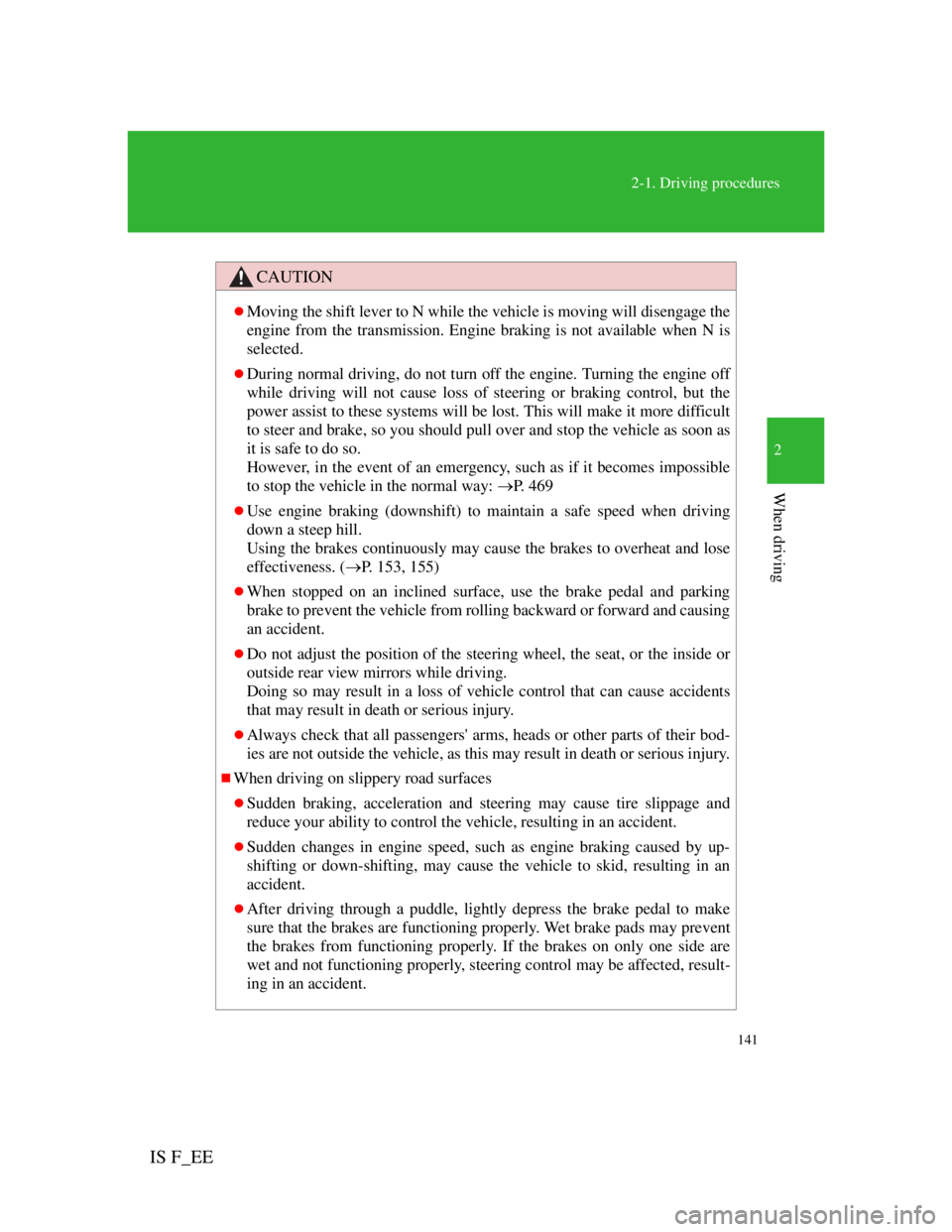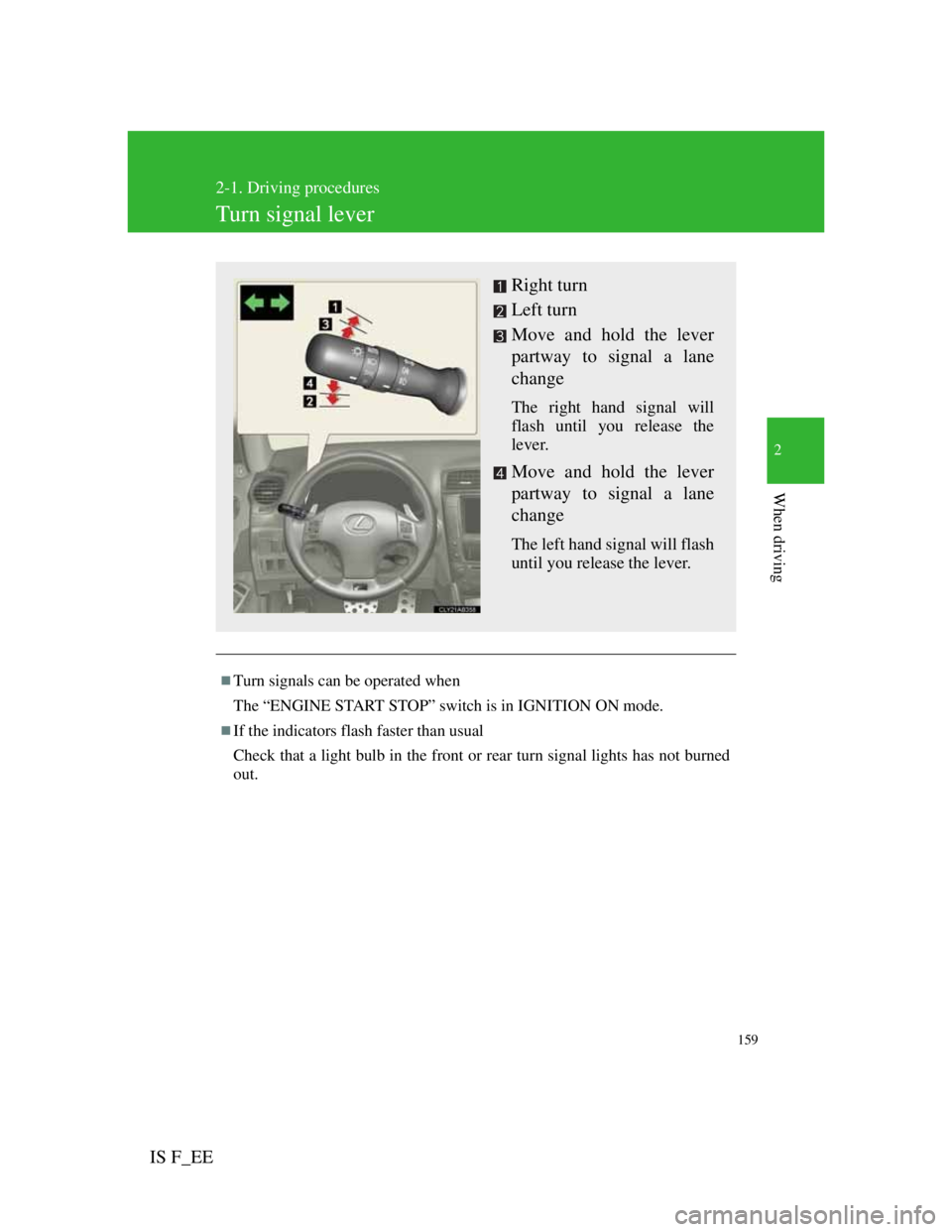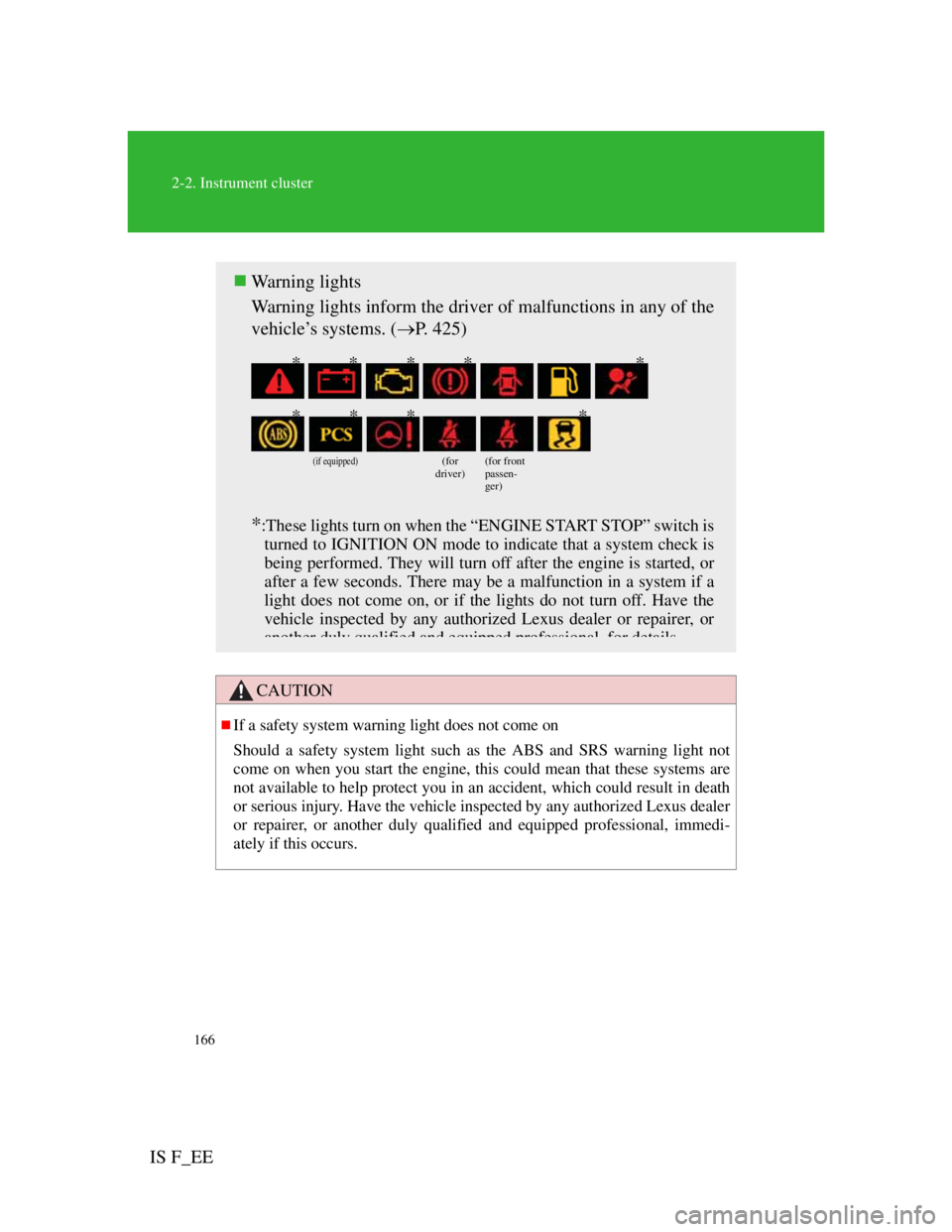check engine light Lexus IS F 2011 Owner's Manual
[x] Cancel search | Manufacturer: LEXUS, Model Year: 2011, Model line: IS F, Model: Lexus IS F 2011Pages: 529, PDF Size: 13.89 MB
Page 5 of 529

1
2
3
4
5
6
IS F_EE
5
3-7. Other interior features
Sun visors ........................... 330
Vanity mirrors .................... 331
Clock .................................. 332
Satellite switches ................ 333
Ashtrays ............................. 336
Cigarette lighter.................. 337
Power outlet ....................... 338
Seat heaters ........................ 339
Armrest............................... 341
Trunk storage extension ..... 342
Coat hooks.......................... 344
Floor mat ............................ 345
Trunk features .................... 3464-1. Maintenance and care
Cleaning and protecting the
vehicle exterior................. 350
Cleaning and protecting the
vehicle interior ................. 353
4-2. Maintenance
Maintenance requirements . 356
4-3. Do-it-yourself maintenance
Do-it-yourself service
precautions ....................... 359
Hood ................................... 362
Positioning a floor jack ...... 363
Engine compartment .......... 365
Tires ................................... 378
Tire inflation pressure ........ 381
Wheels................................ 383
Air conditioning filter ........ 385
Electronic key battery ........ 388
Checking and replacing
fuses ................................. 390
Light bulbs ......................... 404
4Maintenance and care
Page 150 of 529

140
2-1. Driving procedures
IS F_EE
When starting off
To prevent the vehicle from creeping forward, keep the brake pedal firmly
depressed when shifting the shift lever.
When driving the vehicle
Do not drive if you are unfamiliar with the location of the brake and accel-
erator pedals to avoid depressing the wrong pedal.
• Accidentally depressing the accelerator pedal instead of the brake
pedal will result in sudden acceleration that may lead to an accident
that could result in death or serious injury.
• When backing up, you may twist your body around, leading to a diffi-
culty in operating the pedals. Make sure to operate the pedals properly.
• Make sure to keep a correct driving posture even when moving the
vehicle only slightly, allowing you to depress the brake and accelerator
pedals properly.
• Depress the brake pedal using your right foot. Depressing the brake
pedal using your left foot may delay response in an emergency, result-
ing in an accident.
Do not drive the vehicle over or stop the vehicle near flammable materi-
als.
Do not let the vehicle roll backwards while the shift lever is in a driving
position, or roll forward while the shift lever is in R.
Doing so may cause the engine to stall or lead to poor brake and steering
performance, resulting in an accident or damage to the vehicle.
If the smell of exhaust is noticed inside the vehicle, open the windows and
check that the trunk is closed. Large amounts of exhaust in the vehicle can
cause driver drowsiness and an accident, resulting in death or a serious
health hazard. Have the vehicle inspected by any authorized Lexus dealer
or repairer, or another duly qualified and equipped professional, immedi-
ately.
Do not shift the shift lever to P while the vehicle is moving.
Doing so can damage the transmission and may result in a loss of vehicle
control.
Do not shift the shift lever to R while the vehicle is moving forward.
Doing so can damage the transmission and may result in a loss of vehicle
control.
Do not shift the shift lever to D while the vehicle is moving backward.
Doing so can damage the transmission and may result in a loss of vehicle
control.
Page 151 of 529

141
2-1. Driving procedures
2
When driving
IS F_EE
CAUTION
Moving the shift lever to N while the vehicle is moving will disengage the
engine from the transmission. Engine braking is not available when N is
selected.
During normal driving, do not turn off the engine. Turning the engine off
while driving will not cause loss of steering or braking control, but the
power assist to these systems will be lost. This will make it more difficult
to steer and brake, so you should pull over and stop the vehicle as soon as
it is safe to do so.
However, in the event of an emergency, such as if it becomes impossible
to stop the vehicle in the normal way: P. 4 6 9
Use engine braking (downshift) to maintain a safe speed when driving
down a steep hill.
Using the brakes continuously may cause the brakes to overheat and lose
effectiveness. (P. 153, 155)
When stopped on an inclined surface, use the brake pedal and parking
brake to prevent the vehicle from rolling backward or forward and causing
an accident.
Do not adjust the position of the steering wheel, the seat, or the inside or
outside rear view mirrors while driving.
Doing so may result in a loss of vehicle control that can cause accidents
that may result in death or serious injury.
Always check that all passengers' arms, heads or other parts of their bod-
ies are not outside the vehicle, as this may result in death or serious injury.
When driving on slippery road surfaces
Sudden braking, acceleration and steering may cause tire slippage and
reduce your ability to control the vehicle, resulting in an accident.
Sudden changes in engine speed, such as engine braking caused by up-
shifting or down-shifting, may cause the vehicle to skid, resulting in an
accident.
After driving through a puddle, lightly depress the brake pedal to make
sure that the brakes are functioning properly. Wet brake pads may prevent
the brakes from functioning properly. If the brakes on only one side are
wet and not functioning properly, steering control may be affected, result-
ing in an accident.
Page 153 of 529

143
2-1. Driving procedures
2
When driving
IS F_EE
CAUTION
When the vehicle is parked
Do not leave glasses, cigarette lighters, spray cans, or soft drink cans in
the vehicle when it is in the sun.
Doing so may result in the following.
• Gas may leak from a cigarette lighter or spray can, and may lead to a
fire.
• The temperature inside the vehicle may cause the plastic lenses and
plastic material of eye glasses to deform or crack.
• Soft drink cans may fracture, causing the contents to spray over the
interior of the vehicle, and may also cause a short circuit in the vehi-
cle's electrical components.
Always apply the parking brake, shift the shift lever to P, stop the engine
and lock the vehicle.
Do not leave the vehicle unattended while the engine is running.
Do not touch the exhaust pipes or rear bumper exhaust diffusers while the
engine is running or immediately after turning the engine off.
Doing so may cause burns.
Do not leave the engine running in an area with snow build-up, or where it
is snowing. If snowbanks build up around the vehicle while the engine is
running, exhaust gases may collect and enter the vehicle. This may lead to
death or a serious health hazard.
Exhaust gases
Exhaust gases include harmful carbon monoxide (CO) that is colorless and
odorless. Inhaling exhaust gases may lead to death or a serious health haz-
ard.
If the vehicle is in a poorly ventilated area, stop the engine. In a closed
area, such as a garage, exhaust gases may collect and enter the vehicle.
This may lead to death or a serious health hazard.
The exhaust should be checked occasionally. If there is a hole or crack
caused by corrosion, damage to a joint or abnormal exhaust noise, be sure
to have the vehicle inspected and repaired by any authorized Lexus dealer
or repairer, or another duly qualified and equipped professional. Failure to
do so may allow exhaust gases to enter the vehicle, resulting in death or a
serious health hazard.
Page 169 of 529

159
2-1. Driving procedures
2
When driving
IS F_EE
Turn signal lever
Turn signals can be operated when
The “ENGINE START STOP” switch is in IGNITION ON mode.
If the indicators flash faster than usual
Check that a light bulb in the front or rear turn signal lights has not burned
out.
Right turn
Left turn
Move and hold the lever
partway to signal a lane
change
The right hand signal will
flash until you release the
lever.
Move and hold the lever
partway to signal a lane
change
The left hand signal will flash
until you release the lever.
Page 176 of 529

165
2-2. Instrument cluster
2
When driving
IS F_EE
Indicators
The indicators inform the driver of the operating state of the
vehicle’s various systems.
*1:These lights turn on when the “ENGINE START STOP” switch
is turned to IGNITION ON mode to indicate that a system check
is being performed. They will turn off after the engine is started,
or after a few seconds. There may be a malfunction in a system if
a light does not come on, or if the lights do not turn off. Have the
vehicle inspected by any authorized Lexus dealer or repairer, or
another duly qualified and equipped professional, for details.
*2Th li ht fl h t i di t th t th t i ti
Turn signal indicator
(P. 159)Cruise control indicator
(P. 180, 184)
Headlight high beam
indicator (P. 172)
(if
equipped)
Lexus parking assist-
sensor indicator (P.
199)
Tail light indicator
(P. 172)Slip indicator (P.
206)
Front fog light indicator
(P. 175)VSC off indicator
(P. 206)
Rear fog light indicator
(P. 175)“TRC OFF” indicator
(P. 206)
“SNOW” indicator
(P. 152)SRS airbag on-off indi-
cator (P. 135)
“SPORT” indicator
(P. 152, 207)“DRL OFF” indicator
(P. 173)
*1,
*
*
*
Page 177 of 529

166
2-2. Instrument cluster
IS F_EE
CAUTION
If a safety system warning light does not come on
Should a safety system light such as the ABS and SRS warning light not
come on when you start the engine, this could mean that these systems are
not available to help protect you in an accident, which could result in death
or serious injury. Have the vehicle inspected by any authorized Lexus dealer
or repairer, or another duly qualified and equipped professional, immedi-
ately if this occurs.
Warning lights
Warning lights inform the driver of malfunctions in any of the
vehicle’s systems. (P. 425)
*:These lights turn on when the “ENGINE START STOP” switch is
turned to IGNITION ON mode to indicate that a system check is
being performed. They will turn off after the engine is started, or
after a few seconds. There may be a malfunction in a system if a
light does not come on, or if the lights do not turn off. Have the
vehicle inspected by any authorized Lexus dealer or repairer, or
another duly qualified and equipped professional for details
(if equipped)(for
driver)(for front
passen-
ger)
*****
****
Page 368 of 529

4Maintenance and care
349
IS F_EE
4-1. Maintenance and care
Cleaning and protecting
the vehicle exterior ........ 350
Cleaning and protecting
the vehicle interior ......... 353
4-2. Maintenance
Maintenance
requirements .................. 3564-3. Do-it-yourself
maintenance
Do-it-yourself service
precautions..................... 359
Hood ................................ 362
Positioning a floor jack .... 363
Engine compartment ........ 365
Tires ................................. 378
Tire inflation pressure ...... 381
Wheels ............................. 383
Air conditioning filter ...... 385
Electronic key battery ...... 388
Checking and replacing
fuses ............................... 390
Light bulbs ....................... 404
Page 427 of 529

407
4-3. Do-it-yourself maintenance
4
Maintenance and care
IS F_EE
Light bulbs
You may replace the following bulbs yourself. For more information
about replacing other light bulbs, contact any authorized Lexus dealer
or repairer, or another duly qualified and equipped professional.
Preparing a replacement light bulb
Check the wattage of the light bulb being replaced. (P. 481)
Removing the engine compartment cover
P. 367
Front bulb locations
Front fogHeadlight high
beamFront turn
signal light
Page 463 of 529

440
5-2. Steps to take in an emergency
IS F_EE
Follow the correction procedures.
After taking the specified steps to correct the suspected problem,
check that the warning light turns off.
Inte-
rior
buzzerExte-
rior
buzzer
Warning messageDetailsCorrection
procedure
Once
(Comes on for 10 sec-
onds.)
Indicates that an
attempt was
made to start the
engine without
the electronic
key being pres-
ent, or the elec-
tronic key was
not functioning
normally.
Start the engine
with the elec-
tronic key
present.
*
Once3
times
(Flashing)
Indicates that a
door other than
the driver’s door
has been opened
and closed with
the “ENGINE
START STOP”
switch in any
mode other than
OFF and the
electronic key
has been taken
out of the detec-
tion area.
Confirm the
location of the
electronic key.